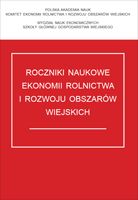Main Article Content
Article Details
Bakalarska Justyna, 2016: Narzędzia marketingu zintegrowanego, „Marketer+”, https://goo.gl/k2HD6K (dostęp: 10.11.2017).
Broda Bartosz, Maziarz Marek, Piekot Tomasz, Radziszewski Adam, 2010: Trudność tekstów o Funduszach Europejskich w świetle miar statystycznych, „Rozprawy Komisji Językowej WTN”, nr 37, s. 23-40.
Czerepowicka Monika, 2016: Możliwości zastosowania narzędzia do pomiaru zrozumiałości tekstu Jasnopis w praktyce szkolnej, „Prace Językoznawcze”, nr XVIII(4), s. 5-18.
Evans Michael P., 2007: Analysing Google rankings through search engine optimization data, „Internet Research”, Vol. 17(1), pp. 21-37. doi: 10.1108/10662240710730470 (Crossref)
Glosariusz, 2004: Glosariusz terminów z zakresu testowania biegłości językowej, Universitas, Kraków.
Gruszczyński Włodzimierz, Broda Bartosz, Nitoń Bartłomiej, Ogrodniczuk Maciej, 2015: W poszukiwaniu metody automatycznego mierzenia stopnia zrozumiałości, „Poradnik Językowy”, nr 2, s. 9-22.
Gruszczyński Włodzimierz, Ogrodniczuk Maciej (red.), 2015: Jasnopis, czyli mierzenie zrozumiałości polskich tekstów użytkowych, Wydawnictwo ASPRA-JR.
Gunning Robert, 1952: The technique of clear writing, McGraw-Hill, New York.
Habrajska Grażyna, 2017: Stylistyczne gatunki reklamy [w] Manual – reklama. Podręcznik z zakresu projektowania komunikacji, Mariusz Wszołek (red.), Wydawnictwo LIBRON – Filip Lohner, Wrocław, s. 121-133.
Król Karol, 2016: Globalne zmiany technologiczne i ich wpływ na promocję agroturystyki w internecie, „Roczniki Naukowe Ekonomii Rolnictwa i Rozwoju Obszarów Wiejskich”, T. 103, z. 3, s. 84-100.
Król Karol, 2017a: Konwersja celu w internetowej sprzedaży produktów turystyki wiejskiej, „Problemy Drobnych Gospodarstw Rolnych – Problems of Small Agricultural Holdings”, nr 2, s. 33-40. doi: 10.15576/PDGR/2017.2.33 (Crossref)
Król Karol, 2017b: Wydajność witryn internetowych gospodarstw agroturystycznych, „Roczniki Naukowe Ekonomii Rolnictwa i Rozwoju Obszarów Wiejskich”, T. 104, z. 3, s. 33-43. doi: 10.22630/RNR.2017.104.3.19 (Crossref)
Król Karol, Wojewodzic Tomasz, 2006: Strona internetowa źródłem przewagi konkurencyjnej gospodarstwa agroturystycznego, „Wieś i Doradztwo”, nr 1-2(45-46), s. 59-62.
Krupa Marianna, 2017: 11 błędów, które nagminnie popełniają copywriterzy, „Sprawny.marketing”, nr 2(2), s. 53-58.
Krzyżanowska Krystyna, 2014: Skuteczność działań informacyjno-promocyjnych w turystyce wiejskiej, „Zeszyty Naukowe Uniwersytetu Szczecińskiego. Ekonomiczne Problemy Turystyki”, nr 3(27), s. 41-55.
Krzyżanowska Krystyna, Wojtkowski Rafał, 2012: Rola internetu w promocji usług agroturystycznych, „Economic and Regional Studies”, nr 5(1), s. 48-57.
Kubik-Przybył Adrianna, 2016: Jak trendy w konsumpcji treści online wpływają na działania content marketingowe?, „Raport IAB Polska: Konsumpcja treści online a marketing”, s. 4-7.
Kukuła Karol, Bogocz Danuta, 2014: Zero unitarization method and its application in ranking research in agriculture, „Economic and Regional Studies”, Vol. 7(3), pp. 5-13.
Łopacińska Ludmiła, Wnuk Urszula, 2014: Analiza indeksu mglistości tekstu w raportach ewaluacyjnych strategicznych programów badawczych w obszarze innowacji technicznych, „E-mentor”, nr 5(57), s. 43-49. doi: 10.15219/em57.1141. (Crossref)
Miodek Jan, Maziarz Marek, Piekot Tomasz, Poprawa Marcin, Zarzeczny Grzegorz, 2010: Jak pisać o Funduszach Europejskich?, Ministerstwo Rozwoju Regionalnego, Warszawa.
Nieto Jannine, Hernández-Maestro Rosa M., Muñoz-Gallego Pablo A., 2011: The influence of entrepreneurial talent and website type on business performance by rural tourism establishments in Spain, „International Journal of Tourism Research”, Vol. 13(1), pp. 17-31. doi: 10.1002/jtr.794. (Crossref)
Penolazzi Barbara, Hauk Olaf, Pulvermüller Friedemann, 2007: Early semantic context integration and lexical access as revealed by event-related brain potentials, „Biological Psychology”, Vol. 74(3), pp. 374-388. doi: 10.1016/j.biopsycho.2006.09.008. (Crossref)
Piekot Tomasz, Zarzeczny Grzegorz, Moroń Ewelina, 2015: Upraszczanie tekstu użytkowego jako (współ)działanie. Perspektywa prostej polszczyzny [w] Działania na tekście. Przekład-redagowanie-ilustrowanie, Stanisława Niebrzegowska-Bartmińska, Marta Nowosad-Bakalarczyk, Tomasz Piekot (red.), Wyd. UMCS, Lublin, s. 99-116.
Rasmusson Maria, Eklund Monica, 2013: It’s easier to read on the Internet – you just click on what you want to read… „Education and Information Technologies”, Vol. 18(3), pp. 401-419. doi: 10.1007/s10639-012-9190-3 (Crossref)
Seretny Anna, 2006: Wskaźnik czytelności tekstu jako pomoc w określaniu stopnia jego trudności, „LingVaria”, no. 2, s. 87-98.
Shenoy Aravind, Prabhu Anirudh, 2016: Introducing SEO: Your quick-start guide to effective SEO practices, Apress, Berkeley, CA. doi: 10.1007/978-1-4842-1854-9 (Crossref)
Shih Bich-Yaw, Chen Chen-Yuan., Chen Zih-Siang, 2013: Retracted: an empirical study of an internet marketing strategy for search engine optimization, „Human Factors and Ergonomics in Manufacturing & Service Industries”, Vol. 23(6), pp. 528-540. doi: 10.1002/hfm.20348 (Crossref)
Sikora Jan, Wartecka-Ważyńska Agnieszka, 2016: Reklama internetowa w promocji ruchu turystycznego na wsi, „Zeszyty Naukowe Uniwersytetu Szczecińskiego. Ekonomiczne Problemy Turystyki”, nr 1(33), s. 211-224. (Crossref)
Słabczyński Robert, 2014: Sprawdź i odbierz prezent – o słownictwie tematów e-maili marketingowych, „SŁOWO. Studia językoznawcze”, nr 5, s. 201-211.
Stawarz-García Barbara, 2017: 5 chybień. Jak naprawić błędy w działaniach content marketingowych, „Sprawny.marketing”, nr 2(2), s. 45-48.
Świeczak Witold, 2013: Content marketing jako istotny element strategii marketingowej instytucji naukowych, „Marketing i Rynek”, nr 10(20), s. 16-24.
Zarzeczny Grzegorz, 2014: Leksyka w ujęciu ilościowym (na materiale wybranych wrocławskich podręczników) [w] 40 lat wrocławskiej glottodydaktyki polonistycznej. Teoria i praktyka, Anna Dąbrowska, Urszula Dobesz (red.), Oficyna Wydawnicza ATUT, Wrocław, s. 373-383.
Zopounidis Constantin, Lemonakis Christos, Andreopoulou Zacharoula, Koliouska Christiana, 2014: Agrotourism Industry Development through Internet Technologies: A Multicriteria Approach, „Journal of Euromarketing”, Vol. 23(4), pp. 45-67. doi: 10.9768/0023.04.045 (Crossref)
Downloads
- Małgorzata Raczkowska, Joanna Wrzesińska-Kowal, Inequality and economic poverty in rural areas of Poland , Annals of Agricultural Economics and Rural Development: Vol. 105 No. 1 (2018)
You may also start an advanced similarity search for this article.
- Karol Król, The degree of optimization of websites of rural tourism facilities for search engines , Annals of Agricultural Economics and Rural Development: Vol. 105 No. 2 (2018)
- Karol Król, GLOBAL TECHNOLOGICAL CHANGES AND THEIR INFLUENCE ON THE PROMOTION OF AGRITOURISM ON THE INTERNET , Annals of Agricultural Economics and Rural Development: Vol. 103 No. 3 (2016)
- Karol Król, EFFICIENCY OF WEBSITES OF AGROTOURISTIC FARMS , Annals of Agricultural Economics and Rural Development: Vol. 104 No. 3 (2017)
- Karol Król, EVALUATING RURAL COMMUNITIES WEBSITES IN MAŁOPOLSKA FOR ACCESSIBILITY , Annals of Agricultural Economics and Rural Development: Vol. 103 No. 1 (2016)




